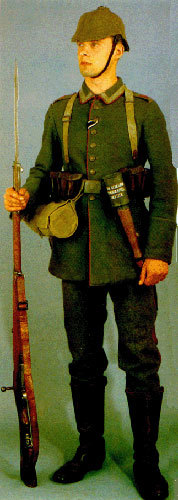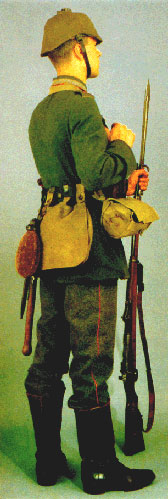|
1. M.1915 Helm (helmet), the last of the spiked Pickelhaube series, soon to be replaced by a new steel design. In most cases the skull of this helmet remained in boiled leather, but there were also examples made of felt, of compressed cardboard, and of thin metal (which still offered no serious protection). The helmet fittings were in all cases made of a white metal alloy, painted grey. The spike, judged to be too obviously visible, was now removed on campaign by means of a "bayonet-socket" fixing. The cloth helmet cover therefore lost its own point; and, also for reasons of concealment, its red regimental numbers.
2. M.1914 Feldbluse (also called the "Transitional" tunic by collectors), a simplified version of the M.1907/10 Feldbluse. The cut was more close-fitting; the tone of the field grey cloth became darker and greener; and the fancy cuffs and false skirt pocket flaps were omitted. The cuffs themselves became a deeper `Swedish' style; and the NCO's braid was only displayed on the collar. The shoulder straps of field-grey cloth were now piped in white for all infantry formations, with unit numbers or monograms embroidered in red; the straps were now sewn down at the shoulder seams. The black and white ribbon worn in the second buttonhole marks an award of the Iron Cross 2nd Class.
3. M.1895 Koppel now blackened, and with an iron Koppelschloß (buckle), painted feldgrau; older two-metal (brass-nickel, etc.) buckle plates still in use were similarly painted over.
4. M.1909 Patronentaschen; the new regulations called for them to be blackened, but the nature of the leather used made this difficult to achieve consistently.
5. The Soldat illustrated wears lightened field equipment, with out the cumbersome M.1895 Tornister. The considerable weight of the cartridge pouches with 90 rounds in them led to the use of the Brotbeutelriemen (breadbag strap) as a neck brace in the absence of the Tornister's shoulder straps.
6. M.1915 Gasmaske (gasmask); this early model was called the Gummimaske and was comprised a mask of rubberized fabric and a detachable filter cartridge, which were carried (along with a spare filter cartridge) in a strong cloth bag looped to the belt.
7. M.1915 Stielhandgrenate (hand grenade) often referred to by colectors as a "stick grenade" or "potato-masher".
8. M.1887 Brotbeutel, in this case a wartime example in poor quality grey fabric.
9. The M.1907 Feldflasche, also of ersatz manufacture, here in enameled iron covered with brown corduroy cloth, probably of civilian origin. The attachment strap system has been reduced to its simplest form.
10. M.1887 Schanzzeug in its leather carrier, secured to the scabbard of the M.1898/05 "Butcher" bayonet by a strap.
11. M.1907/10 Hosen; these were identical in cut and pocket details to the M.1907/10 pattern, but made of steingrau (stone-grey) cloth. This was chosen when it was discovered that the feldgrau trousers rapidly faded with use; this darker shade lasted longer. The red piping down the outer seams was retained.
12. M.1886 Marschstiefel (marching boots) in tan leather, flesh side out; these were ordered blackened in 1915.
13. M.1898 Mauser Gewehr 98 (rifle '98), in 7.92x57mm caliber.
14. M.1898/05 "Butcher" Seitengewehr (bayonet). Originally introduced for the foot artillery, with a leather scabbard, it was issued from 1915 on, to the whole infantry arm along with a sturdier all-metal scabbard. This bayonet replaced the longer and more fragile M.1898 "feather" bayonet.
|





